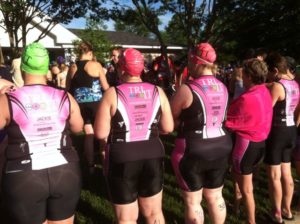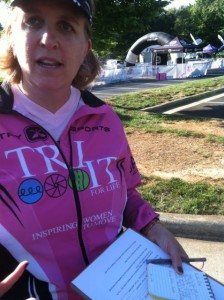
I wrote the following for the Charlotte Observer and The News & Observer of Raleigh; it appeared in both papers yesterday, Tuesday, June 12. It appears here, with links.
The idea of getting someone with zero interest in running to up and do a 5K seemed crazy not that long ago. But in the past several years, 12-week programs designed to do exactly that — the so-called zero-to-5K programs — have flourished.
So how about the notion of targeting a similarly inactive audience to run that 5K after they’ve already biked 10 miles and swam 250 yards?
It’s proving equally as popular, according to Tri It For Life, a Charlotte-based non-profit that has turned 700 nonathletes into triathletes over the past six years and is expanding into the Triangle this fall. Its success has less to do with the promise of Olympic gold or weight loss than with something a lot of women find even more elusive.
“Every day I see women who have lost themselves,” says Tri It For Life founder Alyse Kelly-Jones, a Charlotte OB/GYN. “They take care of their family, they have a job. They don’t do anything for themselves every day.”
A triathlete herself, Kelly-Jones got the idea for TriItForLife in 2004 at the inaugural Ramblin’ Rose Chapel Hill Triathlon. (Ramblin’ Rose is a women’s-only sprint triathlon series that now includes five triathlons and one half marathon in the Carolinas.) She did the race with some friends, and near the end saw one little girl stopping to help another who was struggling.
“I thought, ‘Wow, that’s pretty cool!’ Kelly-Jones recalls. That episode led her to create an informal group to train for a sprint triathlon the following year in Charlotte. Not all the signs from that initial effort were encouraging: Kelly-Jones recalls one of her charges crossed the finish line, came up to her and yelled, “I hate you, Alyse! I’m never doing this again!”

She’s not exaggerating. “Yep, that’s pretty much the way it happened,” recalls Angela Mason, who uttered the invective. And yet, Mason found that she had fallen under Kelly-Jones’s positive reinforcement spell.
“Alyse can convince anyone to do anything,” says Mason. Like get back on the horse, which Mason did with vigor. She’s since become an avid triathlete, completing last year’s Beach2Battleship Half Ironman — 1.2-mile open water swim, 56-mile bike ride, 13.1-mile run — in Wilmington.
The following year, Kelly-Jones put together the Ramblin’ 100 to train for Ramblin’ Rose Charlotte. After that proved successful, her friends told her there was no way she could quit now.
In 2008, the 501(c)3 non-profit TriItForLife was formed.
Like the popular zero to 5K running programs, Tri It For Life works on a 12-week cycle that trains runners for a graduation event. Tri It For Life offers two sessions; the first begins in March, targeting the Ramblin’ Rose Rock Hill, the second, which is underway, targeting July’s Ramblin’ Rose Charlotte. Training sessions are held throughout the week, with separate sessions for the swim, run and bike, and Sunday usually reserved for a “brick” workout — a bike ride followed by a run.
Sprints are the shortest triathlons. In the case of the Ramblin’ Rose tris, the swim is either 225 or 250 yards (9 or 10 lengths in 25-yard pool), the bike ride 8 or 9 miles, the run 2 miles. Kelly-Jones says the hardest event for most women is the swim. Carol Gore of Fort Sill, S.C., would agree with that.
Gore graduated from a zero to 5K program two years ago, got hooked on running and has since run two marathons. Along the way, friends kept saying, “You should try a triathlon.”
Kelly-Jones says most of the non-swimmers who come to Tri It For Life simply never swam as kids. That was true for Gore, whose challenge was complicated by a morbid fear of water.
Gore was inspired to face her fear after a friend who’d been hit by a car training for the Lake Placid Ironman got back on the bike as soon as he could. Says Gore, “I figured if he could get back on the bike, then I could overcome my fear of water.”
She started this past January, two months before her Tri It For Life training began, by donning goggles, sticking her face in a bowl of warm water in her kitchen and blowing bubbles. “Even that terrified me,” she says. “I was afraid I was going to drown in my own kitchen.”
On her first day in the pool, her fear ratcheted up a notch. “The water was cold, I was clutching the side of the pool for dear life,” Gore recalls, her voice breaking. “I was crying the whole day.”
Her Tri It For Life mentors got her out of the water, got her settled. That was on March 25, a Saturday, she remembers, at 11 a.m. The following Monday she was back in the pool, still terrified, but a bit less so. And so it’s gone every week since. Now, she’s able to swim a few yards and is already contemplating life beyond Ramblin’ Rose Rock Hill.
“My dream is to do a half ironman,” she says, “the Beach2Battleship.”
Mary Rowens of Mint Hill is perhaps more typical of the Tri It For Life rank and file. Active in her youth — playing basketball and softball in high school and crewing in college — she had since fallen into the post-college work/family time suck. Then, a year ago after the birth of her second child she began having “blood pressure issues.”
“I needed to get healthy,” she says.
The Tri It For Life concept appealed for two reasons. One, the encouragement of training with others. “
There’s a real comradery, an accountability,” says Rowens. “If you miss a practice it’s like, ‘Hey, where were you?’ You don’t get that feeling of being alone, like you’re the only one doing it.”
And two, she liked the variety of training for three events instead of just one.
“The idea of a triathlon was intimidating, like something a real athlete would do,” she says. “Yet I liked the idea of different sports, of doing something different every time.”
Tri It For Life’s growth is especially impressive considering the program only takes first-timers. (Some graduates of the program return as mentors, another program plus, says Rowens. “The mentors are everyday people. They’re not swim instructors giving you things technically.”) Kelly-Jones says they wanted to get the concept nailed down before expanding into new markets. Already, 75 women have signed up for an introductory meeting in Raleigh in September. A similar meeting is planned for Winston-Salem in August.
Finding mentors to continue the message of Tri It For Life is the least of Kelly-Jones’ concerns, thanks to an abundance of satisfied graduates.
“I’m really excited to come back as a mentor, to work with other athletes,” says Rowens. “I’ve developed a new appreciation for telling people, ‘You can do this.’”
* * *
For more information on Tri It For Life and it’s Charlotte programs, go here. You’ll also be able to find information on the Raleigh and Winston-Salem introductory meetings at the site.
* * *
Tri it on your own
Interested in training for a sprint triathlon on your own? Here’s how the 12-week training program used by Tri It For Life works
Swim. TriItForLife divides swimmers into four categories based on level of experience. For those with some comfort in the water, there are Levels 1 (beginner) through 3 (accomplished lap swimmers). The hydrophobic are dubbed “Bubble Blowers” and are enrolled in an extra four-week session where they start by learning to breath underwater.
Swim workouts are held twice a week, beginning with 200 yards (8 lengths in a 25-yard pool) in week one and working up to 600 yards (24 lengths) by week 9. That’s not necessarily 600 continuous yards, but rather shorter swims of increasingly longer duration.
Run. There are two scheduled runs per week, starting with 15-minute runs in week 1 and working up to 50-minute runs by week 8. Again, that’s not necessarily 15 or 50 minutes of continuous running. Initially, athletes may run for a minute, walk for three minutes. The goal is to increase the amount of running time, decrease the walking.
Bike. Because not all newbies are comfortable riding a bike in traffic, sessions begin in a parking lot and advance to a nearly closed 3-mile circuit in a business park. Eventually, the group is taken onto streets to ride in moderate traffic. “We always ride as a group,” says Tri It For Lifer Mary Rowens. “We have mentors in front of us and mentors in the rear. The group mentality helps us feel safe.” The bike rides eventually reach 15 miles on the road. They are also done twice a week.
Brick workouts. These are simply two workouts, one after the other, to simulate the triathlon experience. Tri It For Life begins its brick workouts in week 2, with a 200-yard swim followed by a 15 minute run. Some brick workouts pair swimming with walking, some biking with walking.
For the full 12-week Tri It For Life training program, visit here.
One thought on “Tri it, you may like it”